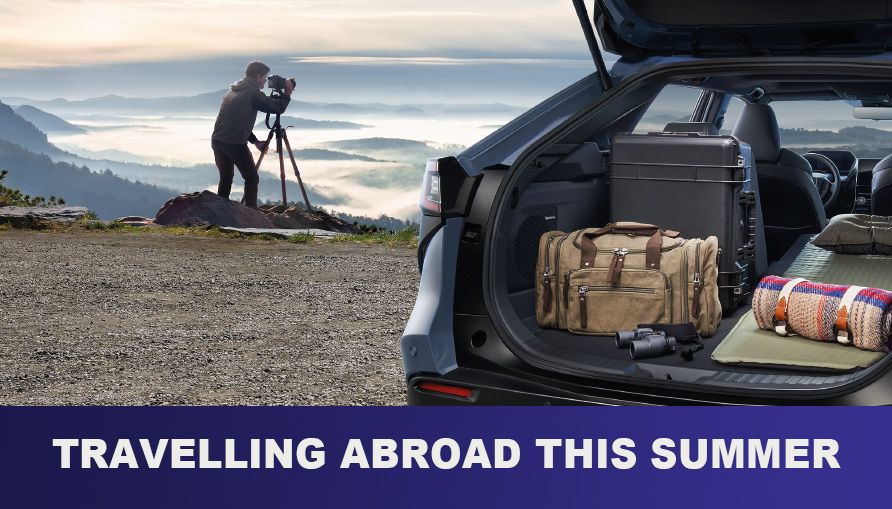Travelling Abroad This Summer
Travelling Abroad This Summer

Are you planning on travelling abroad this year, either in your own vehicle or in a hired one once you arrive at your destination? We’ve put together a list of items you will need to take with you, and some general tips for a safe journey.
Important documents for driving in the EU:
- Your Passport
- A full, valid driving licence.
- Your V5C logbook.
- Your vehicle insurance documents.
- A UK sticker for your car.
- Up-to-date MOT and vehicle tax.
It’s important to be aware that if you’re taking your vehicle out of the UK or ED, you may be required to pay import duty. Depending on your destination, you may need an IDP (International Driving Permit), so be sure to check before you leave.
When travelling abroad there are several additional items that are required to be kept in your vehicle:
- A reflective jacket for each passenger in the vehicle.
- A reflective warning triangle.
- A first aid kit.
- Headlamp beam deflectors.
Things to remember when travelling in a different country:
- Make sure you’re on the correct side of the road – mainland Europe drive on the right. It can be very easy to forget that you’re not in the UK anymore especially when coming to junctions – so be safe while out on the roads.
- Adjust your headlights – It is a legal requirement not to dazzle oncoming drivers. You can purchase headlamp converters.
- Keep your documents safe. Consider putting them in a travel pack so that you have them to hand easily.
- Check to make sure that your car insurance covers you to travel abroad.
- If you are taking any pets, check to see if there are any requirements for travelling with pets.
- Take photographs of your important documents and keep them separate from the original copies – or store them online – in the event of loss or theft.
- Consider European breakdown cover, some standard policies might not cover you abroad.
- Research the rules of the road for the country/countries you’re driving through, familiarise yourself with the Priority Diamond and the ‘proceed with caution’ flashing amber lights.
- Depending on the vehicle you own and where you’re travelling, you may need to check the local emission zones to ensure your car is okay to enter!
- In most countries outside of the UK, speed camera detectors are illegal and should not be used when travelling abroad.
Finally, a few notes on France!
For many, France is the gateway to Europe, so if you are travelling to or through France, it is important to be aware of their tolls!
There are several ways you can pay the toll cost: Any driver can pay for tolls by credit, debit card or by cash for manned toll roads. Most tolls are now automated and unmanned – however, on the larger, busier autoroutes, some continue to provide manned booths.
You can spot a manned toll booth/road, where you can see a sign of a person in a cap above the lane (Remember, all payments must be made in Euros)
Drivers can also use toll tags that allow you to travel through specific gates labelled “T” and you will be billed monthly depending on the tag’s usage. There are many companies that supply this service so it is worth doing some research.
When driving in France remember it is illegal to allow passengers to travel inside a moving caravan.
France also has 2 separate speed limits that are weather-dependent.
For dry weather: Rural 2 & 3-lane roads are a maximum of 80 km/h. 4-lane expressways are a maximum of 110 km/h. Highways are a maximum of 130 km/h in rural areas. There is a maximum of 50 km/h in urban areas. These limits are then adjusted when raining.
It is also worth noting a driving tip for the Paris Ring Road is it has a limit of 80 km/h.













Repairs & Services
- Air Conditioning
- Auto Electrics
- Batteries
- Brakes
- Citroen Repairs
- Clutch Replacement
- Diagnostics
- Engine Management
- EV Repairs & Servicing
- Exhausts
- Gearbox Repairs
- Hybrid Repairs & Servicing
- MOT
- Peugeot Repairs
- Servicing
- Steering
- Subaru Repairs
- Suspension
- Timing Belts & Cambelts
- Tyres
- Van Repairs & Servicing
- Welding
- Wet Belts
- Wheel Alignment
- Wheel Balancing
- All Repairs & Services…





